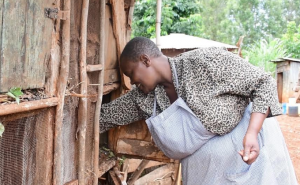As the globe commemorates World Cancer Day on February 4, cancer continues to rear its viciousness, ravaging millions in its wake, leaving behind a trail of deaths, an impact that extends beyond physical health, affecting the emotional and financial well-being of the affected persons and their families.
Cancer, a significant global concern, has been ranked as the second leading cause of deaths worldwide, while in Kenya it is the third leading cause of deaths after cardiovascular and infectious diseases.
However, prevention strategies, early detection, and timely treatment have been confirmed to play a crucial role in combating cancer.
Kenya News Agency walks the journey with a woman who has remained resilient to overcome her breast cancer diagnosis over a year ago.
We arrive at Kagumoini village, Kandara Constituency, at 10 am, where we find Alice Muthoni Gitau going about her morning chores, feeding a warren of rabbits as a herd of goats bleat relentlessly as if competing for her attention.
“It is their time to feed, and they will not rest until I feed them, “she says as she ushers us into her compound, momentarily leaving us to give water to a sow that has been pacing up and down the pig parlour since our arrival.
“Early last year, I noticed a small, painless lump on my left breast, which I brushed off, mistaking it for a mosquito bite, “she reminisces, finally settling down for the interview.
The 50-year-old mother of three all-grown children applied a pain balm on the lump for a few days and went on with her life, oblivious to the outcome that would shock her entire being weeks later.
“Several weeks later, the stubborn ‘mosquito bite” was still present, and I decided to go to Kandara Hospital, and after a physical examination, I was referred to Maragua Level Four Hospital for further tests,” she says.
She was then referred to Murang’a Level Five Hospital for a mammogram. The outcome of the mammogram saw her referred to Santamore Surgical Hospital, where further tests were done, including a biopsy.
By this time, she says her breast had changed in colour, and the skin texture felt different from that of the surrounding tissue.
“After a battery of tests, the news that I had stage one breast cancer was broken to me,” she says, tears welling in her eyes.
Time was of the essence; the doctor recommended urgent removal of the affected breast to prevent it from spreading to other organs.
Muthoni underwent a prophylactic mastectomy, and that marked the beginning of her healing journey, which is far from over, but she is hopeful she will emerge victorious.
On the financial implications the disease has for her family, she notes that all her medical expenses were catered for by the Social Health Insurance fund and calls on those who have not registered with SHA to do so.
“I contribute Sh300 per month, and the medical fees amounting to over Sh200,000 were fully covered by SHA, and as I await a date with an oncologist at KUTTRH who will advise on further treatment regime, I do not have to worry about medical fees as I have been assured it will cover me still,” she says, eyes gazing on the horizon, perhaps hopeful that her healing will certainly come.
She urges the government to provide frequent medical camps even in villages so that women can access screenings on a routine basis for preventative measures as one of the ways to combat cancer.
We further sought expert opinion from Santamore specialist surgical hospital director and anaesthetist Jeremiah Karanja Mugo, who notes that some types of cancer are more prevalent in women than in men, and the most common type of cancer in women is that of the cervix and the breast.
He advocates for screening for early detection because cancer does not have any presenting symptoms until it is advanced in stage.
“Breast and cervical cancer are easily detected early through screening, and the earlier it is detected, the better in terms of treatment and management,” he says.
“Cancer starts from stages 0 to 1 to 2, and at this time, it’s still confined to the primary site where the cells are changing, hence treatable, but at stages 3 and 4, the cancer has already affected other organs at the development site, and treatment becomes challenging,” notes Dr. Karanja.
“I encourage women in their reproductive years to go for screening once per year for early detection because cancer is preventable through the HPV vaccine in young girls and treatable when detected early, “he adds.
According to Dr. Karanja, the diagnosis involves a combination of thorough history and physical examination, imaging tests, biopsies, and laboratory analysis to confirm the presence of cancer cells and determine the type and stage it is in.
Treatment options include surgery, chemotherapy, radiation therapy, targeted therapy, and immunotherapy, whereby a multidisciplinary team will tailor treatment plans to individual patients while considering factors like the cancer stage.
By Florence Kinyua








